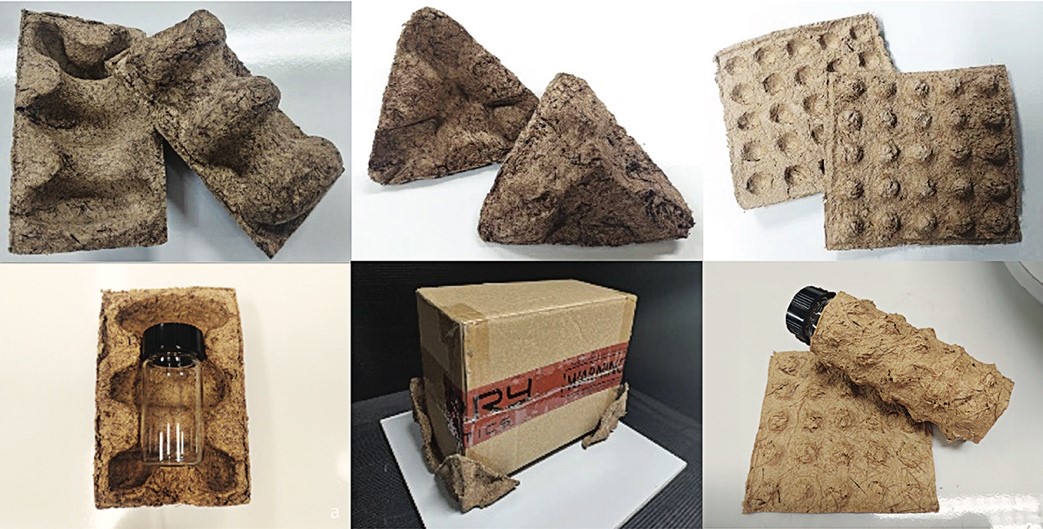Development of Sustainable Packaging Cushions from Coconut Waste Using 3D Printing Techniques 10.32526/ennrj/23/20240224
Main Article Content
Abstract
Coconut fiber and coconut coir dust can be used to create environmentally friendly packaging. Additionally, recycled corrugated paper can be combined with tapioca starch to bind coconut coir dust and paper. Using these techniques, our objective was to develop a novel process for producing different items with coconut pulp paper and 3D-printed molds. The results indicated that the optimal weight ratios of paper, coconut fiber, and coconut coir dust for a bottle, corner cushion and wrapping cushions were 60:20:20, 60:20:20, and 80:20:0, respectively. The 3D-printed molds were designed with rounded chamfers to facilitate easy extraction of the molded paper. Both the bottle and corner cushions exhibited a tensile strength of 0.53 MPa with 12% NaOH treatment. The wrapping cushion demonstrated the highest flexural strength, at 10.33 MPa with 12% NaOH. Overall, NaOH treatment improved the mechanical properties of the coconut fiber compared to untreated fiber. For compression, the bottle and corner cushions achieved values of 3,196.38 N and 1,550.68 N, respectively. Furthermore, both the bottle and wrapping cushions passed the drop test from a height of 150 centimeters. In Thailand, the coconut industry reports revenues of approximately 4.66 billion THB in 2023 and produces 337 million metric tons of waste. This research demonstrates the great potential of coconut by-products, and the utilization of waste valued at 647 million THB. Future studies could explore innovative mold designs to enable the production of more complex packaging and decorative items, further enhancing the economic and environmental benefits of coconut waste utilization.
Article Details

This work is licensed under a Creative Commons Attribution-NonCommercial 4.0 International License.
Published articles are under the copyright of the Environment and Natural Resources Journal effective when the article is accepted for publication thus granting Environment and Natural Resources Journal all rights for the work so that both parties may be protected from the consequences of unauthorized use. Partially or totally publication of an article elsewhere is possible only after the consent from the editors.
References
Banupriya R, Jeevan TP, Divya HV, Yashas Gowda TG, Manjunath GA. 3D-printed graphene-reinforced composites: Opportunities and challenges. Polymer Composit 2024; 46(2):1250-66.
Bradley W, Bradley S. Using coconut fiber and shell as functional fillers in polyolefin to enhance properties and reduce costs. SPE Sustainability Newsletter 2019;7:4-12.
D. Pinho da Costa Castro C, de Assis Fonseca Faria J, Dantas TBH. Testing the use of coconut fiber as a cushioning material for transport packaging. Materials Sciences and Applications 2012;3(3):151-6.
Faria DL, Mendes LM, Junior JBG. Effect of surface treatment on the technological properties of coconut fiber-reinforced plant polyurethane composites. Environmental Science and Pollution Research 2023;30(18):52124-40.
Flowalistik. Pulp it! - 3D printable recycled cardboard molds [Internet]. 2023 [cited 2024 Nov 8]. Available from: https://www.instructables.com/Pulp-It/.
HP Development. HP molded fiber for molded pulp production tooling [Internet]. 2024 [cited 2024 Nov 8]. Available from: https://www.hp.com/us-en/printers/3d-printers/molded-fiber-tooling.html.
Hwang C-L, Tran V-A, Hong J-W, Hsieh Y-C. Effects of short coconut fiber on the mechanical properties, plastic cracking behavior, and impact resistance of cementitious composites. Construction and Build Materials 2016;127:984-92.
Mehdikhani M, Gorbatikh L, Verpoest I, Lomov SV. Voids in fiber-reinforced polymer composites: A review on their formation, characteristics, and effects on mechanical performance. Journal of Composite Materials 2019; 53(12):1579-669.
Mir SS, Hasan SMN, Hossain MJ, Hasan M. Chemical modification effect on the mechanical properties of coir fiber. Engineering Journal 2012;16(2):73-83.
Mohamad MAH, Onn N, Halim MAA, Yahya MS, Haidzir NAFM, Ibrahim MZ. Lean design of alternative packaging cushion material for glass bottles using rice husk and coconut fibre. Journal of Advanced Research in Applied Sciences and Engineering Technology 2024;33(2):107-19.
Mohan S, Thilagavathi G, Rajkhowa R. Composite panels utilizing microdust and coir pith for eco-friendly construction solutions. Journal of the Textile Institute 2025;116(2):175-82.
Othman MH, Main NM, Mon SZK, Mohamad Z. Development of paper using coir fibers as a packaging product. Asian Journal of Scientific Research 2013;6(2):207-16.
Pandiselvam R, Harikrishnan MP, Khanashyam AC, Basil M, Anirudh M, Manikantan MR, et al. Development and characterization of gelatinized starch doped microcellulose paper from tender coconut (Cocos nucifera L) husk. Process Safety and Environmental Protection 2024;184:615-23.
Reddy N, Yang Y. Natural cellulose fibers from corn stover. In: Innovative Biofibers from Renewable Resources. Berlin, Heidelberg: Springer; 2015. p. 5-8.
Rosa MF, Chiou B sen, Medeiros ES, Wood DF, Williams TG, Mattoso LHC, et al. Effect of fiber treatments on tensile and thermal properties of starch/ethylene vinyl alcohol copolymers/coir biocomposites. Bioresource Technology 2009;100(21):5196-202.
Rout J, Tripathy SS, Nayak SK, Misra M, Mohanty AK. Scanning electron microscopy study of chemically modified coir fibers. Journal of Applied Polymer Science 2000;79:1169-77.
Sayakulu NF, Soloi S. The effect of sodium hydroxide (NaOH) concentration on oil palm empty fruit bunch (OPEFB) cellulose yield. Journal of Physics: Conference Series. IOP Publishing 2022;2314(1):Article No. 12017.
Shoeb M, Kandasami RK, Singh S, Sebastian S. Framework for Treatment of coconut coir fibres through physico-chemical techniques. International Journal of Geosynthetics and Ground Engineering 2024;10(2):1-22.
Thyavihalli Girijappa YG, Mavinkere Rangappa S, Parameswaranpillai J, Siengchin S. Natural Fibers as Sustainable and Renewable Resource for Development of Eco-Friendly Composites: A Comprehensive Review. Frontier in Material 2019;6:Article No. 226.
Tran LQN, Minh TN, Fuentes CA, Chi TT, Van Vuure AW, Verpoest I. Investigation of microstructure and tensile properties of porous natural coir fibre for use in composite materials. Industrial Crops and Products 2014;65:437-45.
Vishnu Nandan H, Anish R, Jayaprasad G, Sunny S, Scaria Jomon J, Shibin R, et al. Experimental investigations on the mechanical properties and thermal analysis of coir-paper hybrid composite carry bag material. Materials Letters 2023;353:Article No. 132252.

